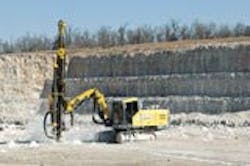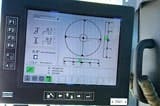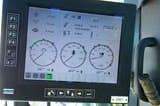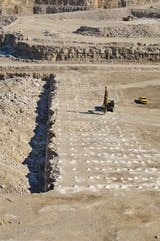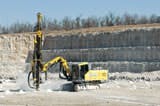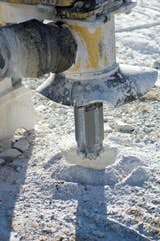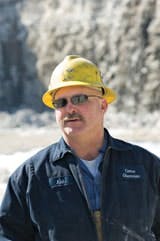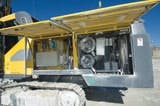Atlas Copco put a unique and potent weapon in the hands of quarries and other rock drillers interested in cutting drilling and blasting costs when the company combined its Rig Control System (RCS) with its Global-Positioning-System-driven Hole Navigation on surface drills. The SmartRig configuration for surface drills debuted in Europe in 2007 and finally made it to North America last year, onto Conco quarries in Springfield, Mo., aboard a ROC F9C, where they're saving enough to recoup the high-tech surface drill's $100,000 price premium in less than three years.
"We were drilling an 8-×12-foot pattern before and we've gone to 10×14 feet," says Chris Upp, Conco's director of quarry operations. "We may be at 12×16 before it's over with — that may work for us."
Agreeing with the adage: "The blast is the most cost-effective primary crusher in the pit," doesn't require overloading with explosives. The industry is finding that drilling precision is one of the keys to making optimum use of the charges loaded into a bench. Electronics used to guide blast holes in tunneling, where navigation accuracy directly influences dollars made or lost on a contract, are being adapted to surface drills.
Like other rock-drill makers, Atlas Copco started using CAN bus hydraulic controllers on underground drill jumbos because the sophisticated electronic systems move the machine's computing power out to the individual hydraulic pumps, motors and cylinders, where the work is being done. Decentralized systems not only simplify the machine's parts manual, but they speed systems' reactions to changing operating conditions.
The bore piloting system monitors down pressure, drill-string torque, and hammer performance, adjusting them to maintain a straight bore, for example, when the bit thrusts into a void or is deflected by a shelf of harder rock. Centralized control systems, with a single computer responding to inputs from sensors mounted on the hydraulic actuators, can't respond as quickly or as accurately as a CAN bus system, which puts computer controllers directly on the pumps, motors and cylinders. Atlas Copco is the first nameplate to bring CAN bus control to a surface drill rig.
"Underground tunneling is a very sophisticated process," says Maurice Hunter, business line manager for Atlas Copco's surface drills. "The profile and direction of the tunnel has to be very precise, so you need very precise control over the drill-and-shoot process.
"The critical thing with surface drilling is typically rock fragmentation — the driller wants to get the shot rock at the right size to reduce the amount of crushing required. The industry is focused on hole diameter and hole straightness. If holes are deviating from the plan, you don't know where the bottom may be. You could get two holes and a lot of explosives close to each other and end up with a fly rock situation, or back blast."
The SmartRig adapts to changes in drilling conditions that deflect the drill bit.
"It can make minor adjustments as it drills," says Upp. "If you hit a void, it adjusts the down pressure and then it can adjust the torque and hammer speed to drill a perfectly vertical hole."
Conco blast holes are all vertical. With a machine suited to drilling consistent holes, the remaining criterion necessary to manage drilling and blasting costs was placing the holes accurately.
One of my main goals in looking at the GPS was to get maximum shot optimization," says Upp. "I want to find how wide of a pattern we can drill and still have an optimum shot."
Conco's F9C SmartRig is equipped with GPS transceivers, and with a reference station set up in the quarry, the system can locate the drill bit to within fractions of an inch. Conco's blaster has mapped the quarry sites using a GPS rover — taking coordinates from all around the benches. To lay out a drill pattern, he gets coordinates from each end of the shot and brings them up on a personal computer using Atlas Copco's ROC Manager software. The system will automatically mark hole locations at whatever pattern is specified.
The blaster checks the layout and adjusts it if necessary, then saves it to a memory card. The memory card is plugged into the slot aboard the F9C and the pattern is downloaded into the RCS display.
The drill operator's monitor displays the pattern, and when he trams the machine to within a few feet of an intended hole, the location pops up on the screen like a bull's-eye. The SmartRig can be switched over to automatic, and it will center the bit on the target to within a tenth of an inch. Or the operator can center the machine over the target manually with the aid of the on-screen target.
"The blaster used to lay out every hole we drilled by painting a rock orange and placing it on the ground to say, 'Drill a hole here,'" says Upp. "If that rock got kicked or the driller drills to one side of it or the other, you don't have a perfect shot layout.
"With GPS being right on the money, you're true to your shot layout," he adds. "That's when you can go in and really optimize and start expanding your pattern because you know that your plan is being followed."
In ten months of gradual expansion, Conco's standard shot layout has grown from 8×12 to 10×14.
"We're looking for a maximum of 48- to 52-inch rock in the shot-rock pile. Our comfort zone has been with a 4-inch hole on a 10×14 pattern, but with GPS and the digital layout system, we can make incremental modifications."
"We're not completely there (to the optimum shot layout) yet, but we're definitely on our way," says Upp, "and we're seeing good results.
"One of the key elements in buying the SmartRig was, 'Can I justify the extra cost for this computerized (machine) by showing that over the life of the drill we will reduce our overall drilling and blasting costs?'"
With five fewer blast holes to drill for each 30,000-ton shot, Upp says his drilling and blasting costs are down 6 to 8 percent (precise costs are elusive, with fluctuations in explosives and labor costs). Estimating conservatively, using the 6-percent savings, Upp expects to cut drilling-and-blasting costs by nearly $40,000 in the first year of owning the F9C SmartRig.
"(Blast optimization) is one of the justifications I used when buying the drill," says Upp. "But it's not a cheap drill."
He is also watching for savings in the drill-string consumables.
In automatic mode, the SmartRig will not only center the drill over the target, but it will automatically collar the hole and commence drilling and adding steel until the bit reaches the desired depth. It will stop automatically, and remove drill steel without operator intervention. All the while, the RCS is monitoring rotation pressure, drill-dampening pressure and penetration rate, and adjusting automatically to changing conditions.
The CAN bus control system's quick, accurate reactions to rock conditions not only reduce the risk of drill strings getting stuck in blast holes, but also result in less wear on bits, steel, and hammer components.
"We're getting in the 30-percent range more life on consumables with the drill automation because you're not adding extra pressure that you don't need to drill the hole," says Upp. "Using a lot of hydraulic sensors, the drill is getting feedback from the steel all the time, and it has the ability to control those things that affect drill life the most — speed, down-the-hole pressure, hammer performance — whereas an operator that didn't have the computerized system is just going to go full bore down the hole until they get done."
Chris Dickinson, field maintenance mechanic at Conco, says the COP 2560 drilling hammer that their F9C carries allows significantly longer shank life.
"Striking bar life, compared to the 1858 (the drill hammer on Conco's previous ROC F9 rig) is better," Dickinson says. "On this one, we replaced one striking bar in the first six months we had it as opposed to, probably, changing three or four striking barson the 1858. It's because the leader system senses rotation speed and down pressure, and doesn't apply any more pressure or hammering than necessary."
The CAN bus control system also extends rig durability if you ascribe to the adage that the reliability of any machine is inversely related to the number of parts that make up the machine. Atlas Copco reduces the number of hydraulic hoses and parts in its SmartRigs by nearly 30 percent, largely because the CAN bus system eliminates hydraulic control lines leading to the controls in the cab. The number of electronic control components and amount of wiring is also sharply curtailed.
The ultimate influence of machine simplification — and newly centralized filter-change station accessible from ground level and other labor-saving maintenance improvements — on SmartRig reliability and operating costs won't be apparent at Conco for some time. Significant benefits related to its drilling accuracy — such as reduced scaling and secondary breaking resulting from more uniform shots, and better haul-truck component life from flatter loading floors and benches — will also have to wait for deeper experience before they can be valued.
Despite impressive estimates of drilling and blasting savings, the computerized drill rig is capable of production improvements that Conco may never see because of the quarry's flat benches and strictly vertical holes. Blast planners should be able to work with a detailed digital terrain map in the ROC Manager software, and adapt blast patterns to deliver consistent shot rock and smooth walls and benches when stripping overburden or even prepping construction sites. Conco has yet to use the Hole Navigation System on virgin rock surfaces.
"I'm not convinced that the Smart Rig is the best drill for every application," Upp says. "It's working well for us in a quarry application, but I think if you're not going to have the drill running every day, you're going to have a hard time overcoming that extra cost.
"I also think eventually we'll all have somebody who's educated enough to be able to plug a (complex) topography into the computer and design a productive shot layout on it. But I haven't yet seen operations, at least in this area, that have been able to do that out on a highway job, or where they're doing a lot of stripping. I think that's why (digital bore planning and guidance) has been fairly slow coming to the U.S."
Nevertheless, even with some specific values missing from the cost/benefit analysis, it appears Conco is convinced the SmartRig is a winner in its relatively simple application.
"Ultimately we're drilling fewer holes for the tonnage and we're using less explosives, so we're driving down our drilling and blasting costs," says Upp, "which is the name of the game."
